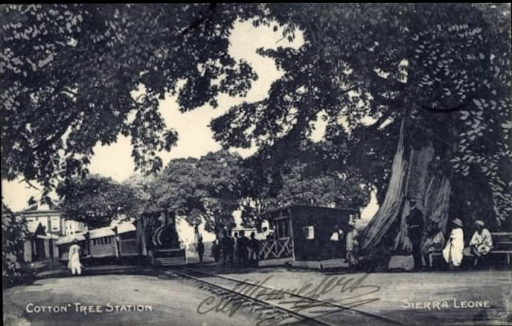Tinap Tranga lek da Big Cotton Tree,
Way breeze nor day shake,
So when Satan (evil or trouble) cam ee nor go able you.
By Adrian Q. Labor

Cotton Tree: From Founding stories of 1792 to the First Train Station in 1903.

Cotton Tree: From a Canopy for the first Train Station to a brisk shade for the Kekeh, a Century and two decades later
“The streets are wide and rather grass-grown,,,,,,,, though the town is by no means well-planted, some beautiful trees to be seen. Government House is embowered in verdure, and the first station on the railway that runs up to the hill-top is “Cotton-tree.” Alone in West Africa 1909-1912 by Mary Guant
The Cotton Tree, was the south-west demarcation of the city of Freetown when its earliest plans were drawn up. It stood at the junction of trails, one of which led to Pademba’s Village.
Pademba’s village was where the town’s children were taken to seek refuge from the French invasion in which they burnt the town in February 1794. I can imagine the children first congregating around its enormous roots before Mary Perth and other mothers took them all up the trail to Pademba.

Cotton Tree: The mysteriously catches fire on a dry night of January 31, 2020

Cotton Tree: Stand strong on February 1, 2020 with internal Injuries from the Fire on its walpole street side
The Cotton Tree has a place in many significant cultural events and so many traditional beliefs by the seventeen nations that called Freetown home. In particular, it is integral to the story of the early founding settlers (Black Poor, Nova scotian, Jamaican Maroons and Emigrated American Families). The founding settlers all gave significance to Cotton Tree as it stood majestically within their neighborhoods or withins sight for the first decade since 1792
The mysterious fire on a dry night of January 31, 2020 remained unexplained but the manner in which the Cotton Tree fell, suggests the damage 2 years ago on its Walpole street side had weakened its core trunk to resist bending under the weight of wet branches and leaves above.
Cotton Tree: The Stormy Night of May 24, 2023
After the fall of the Cotton Tree, Sierra Leonean are telling its stories infused with social history and traditional myths, it is how folktales are birthed. The Cotton Tree took its last stand on the storm night of May 24, 2023 burdened by the nation’s unsettled past, its current political and economic storms and weary of the prevailing winds of tumultuous attitudes. That night the thunders from opposing and chaotic voices on all matters of Sierra Leone grew heavier every hour. The thunders were followed by Lightning strikes that cut through the dark streets and across all dark neighborhoods of the capital city. The lightning lit, briefly and equally, for the Cotton Tree to see the slums in the deltas and on the hillsides of the city’s ravens, the degrading lands of poor and the rich sides of town. There were barely any trees on the mountain tops to absorb some of the storms fury. The rain was continuous and pounding. The skies rained down on the Cotton Tree the cries of every Sierra Leonean. These cries of despair that had once trickled into all the rivers flowing throughout the country which then evaporated into the clouds in the sky above. In times past, the Cotton tree with its full strength, at its core would absorb as much rain. Not this time. The Cotton Tree remember’s the promising conversations for the country that echoed from Thornton Hill Fort, the Governor’s House and the early years of the State House even on nights like these. It was silent just up Independence avenue, so were the halls of Justice in the Law Court building to its side on Siaka Stevens street. It realized it could no longer make out the Parliament at Tower hill in the distance as it was unrecognizable after much ill fated legislation. At about 9:00pm, with Pride that it has stood as a symbol for Freetown for 230 years and the nation of Sierra Leone for 62 years, it took a bow just as the thunder rolled across the city, to hide its painful cry as it broke at its weakest core and fell on Walpole Street. Walpole Street heard the last moan of the Cotton Tree much like whom it was named after. George Wapole had been the sympathetic ear for the Jamaican Trewlany town maroon community back in the island in 1790s. The lone voice of a Freetownian was captured for posterity as he wailed and recorded the Fallen tree at the next lightning strike “ Aaah we Cotton don fordom.” The cotton tree’s truncated stem and root remain as a testament that it would have lived longer, if the nation took pride in itself and even cared for it. The Cotton Tree bowed out as it can no longer be that symbol for the Sierra Leoneans anymore. So, we are tasked with imagining new constructed momentum, more majestic and forward-looking like Senegal and Ghana created with an Africa wide view and vision.

Cotton Tree. Before the Fall. Frail at the core

Cotton Tree. Fallen 9:00pm May 24, 2023

Broken and in Pieces. A bulldozer hauls its remain off. May 25, 2023
